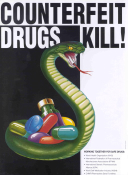By Samuel Greengard
Oct. 15, 2003 – In recent years, the pharmaceutical industry has found itself swallowing a bitter pill: Drug counterfeiting is on the rise. Many of these fake, diluted and mislabeled medications pose a health threat to patients and a financial risk to manufacturers and others in the healthcare industry. The best medicine against counterfeiting?
Some in the pharmaceutical industry believe it may be RFID tags carrying Electronic Product Codes (EPCs).
According to Mark B. McClellan, commissioner of food and drugs at the Food and Drug Administration (FDA) in Washington, D.C., there’s a “significant and growing problem of counterfeit drugs.” The FDA estimates that up to 40 percent of pharmaceuticals shipped from countries such as Argentina, Colombia, and Mexico may be counterfeit. The goal, he says, is to build a “21st century system that can better protect consumers against this emerging public health threat.”
Much of the effort centers on “authentication” and “track and trace” technologies. “The appeal of RFID and EPC technology is the ability to uniquely identify individual products throughout the supply chain and create seamless visibility,” says Lisa Clowers, vice president of Supply Chain Processes & Technology at the Healthcare Distribution Management Association (HDMA), a Reston, Va. nonprofit organization set up to secure safe and effective distribution of healthcare products.
In early October, an FDA Counterfeit Drug Task Force began to examine how EPC technology could improve the handling and security of drugs. A preliminary report issued by the task force suggests that using EPC tags on packages could help identify counterfeit drugs. The tags would carry 96-bit or 128-bit “license plates” that would identify a manufacturer, describe the product and include a unique serial number. Legitimate drug manufacturers overseas would tag their products and customs agencies and distribution companies in the United States would be able to scan the tags and check a database to verify the origin of the shipment.
The system could be used domestically as well. Pharmacies receiving shipments could look up the number in a database and see information about the shipment. If the drugs didn’t have a serial number, or the serial number didn’t match what the company said it shipped, the product could be counterfeit.
If two cases have the same code or other discrepancies appear, it’s obvious that someone has tampered with the shipments or products. The authorities could use the audit trail created when tags are read at each transshipment point in the supply chain to track where counterfeit drugs entered the supply chain.
RFID tracking in general could help improve the integrity of the supply chain. By clearly identifying and tracking products, cartons and pallets, companies can maintain much tighter control over legitimate shipments and ensure that they aren’t hijacked or stolen. This can prevent products from falling into the hands of counterfeiters, who could dilute or alter the drugs and then foist them on unsuspecting pharmacies and consumers.
The FDA only recently mandated the use of bar codes to track drugs, so it is unlikely to require companies to use RFID tags for many years. But major pharmaceutical companies, such as Johnson & Johnson and Eli Lilly and Company, are already exploring the possibility of using EPC tags on drug shipments. While the price of the tags—still at least 50 cents for orders of less than a million pieces—is an inhibitor for other industries, it is less so for drug companies. In many cases, the containers of drugs shipped to pharmacies cost thousands or tens of thousands of dollars.
Only two weeks left until RFID Journal University in New York City. Register now by visiting RFID Journal University, or call 510-832-1501.


